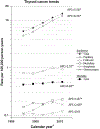The changing incidence of thyroid cancer
- PMID: 27418023
- PMCID: PMC10311569
- DOI: 10.1038/nrendo.2016.110
The changing incidence of thyroid cancer
Abstract
During the past few decades, the incidence of thyroid cancer has increased substantially in many countries, including the USA. The rise in incidence seems to be attributable both to the growing use of diagnostic imaging and fine-needle aspiration biopsy, which has led to enhanced detection and diagnosis of subclinical thyroid cancers, and environmental factors. The latest American Thyroid Association (ATA) practice guidelines for the management of adult patients with thyroid nodules and differentiated thyroid cancer differ substantially from the previous ATA guidelines published in 2009. Specifically, the problems of overdiagnosis and overtreatment of a disease that is typically indolent, where treatment-related morbidity might not be justified by a survival benefit, now seem to be acknowledged. As few modifiable risk factors for thyroid cancer have been established, the specific environmental factors that have contributed to the rising incidence of thyroid cancer remain speculative. However, the findings of several large, well-designed epidemiological studies have provided new information about exposures (such as obesity) that might influence the development of thyroid cancer. In this Review, we describe the changing incidence of thyroid cancer, suggest potential explanations for these trends, emphasize the implications for patients and highlight ongoing and potential strategies to combat this growing clinical and public health issue.
Conflict of interest statement
Competing interests
C.M.K. declares no competing interests. J.A.S. is on the Data Monitoring Committee of the Medullary Thyroid Cancer Consortium Registry, which is sponsored by NovoNordisk, GlaxoSmithKline, Astra Zeneca and Eli Lilly.
Figures

References
-
- Ferlay J, et al. GLOBOCAN 2012 v1.0, Cancer Incidence and Mortality Worldwide: IARC CancerBase No. 11 [Internet]. Lyon, France: International Agency for Research on Cancer; (2013). Available from: http://globocan.iarc.fr, accessed on 5/6/2016.
-
- Ron E, Schneider AB in Cancer Epidemiology and Prevention (ed. Schottenfeld D, Fraumeni JF Jr.) (Oxford University Press, 2006). Chapter 50, pp 975–94.
-
- Kilfoy BA et al. International patterns and trends in thyroid cancer incidence, 1973–2002. Cancer Causes Control 20, 525–31 (2009). - PMC - PubMed
-
Increases in the incidence of thyroid cancer were found in most of the countries with available, high-quality registry data, and no differences were observed by region of the world or underlying thyroid cancer rates.
-
- Enewold L et al. Rising thyroid cancer incidence in the United States by demographic and tumor characteristics, 1980–2005. Cancer Epidemiol Biomarkers Prev 18, 784–91 (2009). - PMC - PubMed
-
This comprehensive descriptive analysis of thyroid cancer trends in the U.S. described increases in incidence of papillary thyroid cancer of all stages and sizes at diagnosis, including similar rates of increase for large (>5 cm) and small (≤1 cm) tumors, suggesting that medical surveillance cannot completely explain these patterns.
-
- Kent WD et al. Increased incidence of differentiated thyroid carcinoma and detection of subclinical disease. CMAJ 177, 1357–61 (2007). - PMC - PubMed
-
Pathology reports obtained from the Ontario Cancer Registry showed an increasing incidence of differentiated thyroid cancer and a disproportionate increase in the number of smaller (≤ 2cm) versus larger tumors between 1990 and 2001.
Publication types
MeSH terms
Supplementary concepts
Grants and funding
LinkOut - more resources
Full Text Sources
Other Literature Sources
Medical
Research Materials
Miscellaneous

